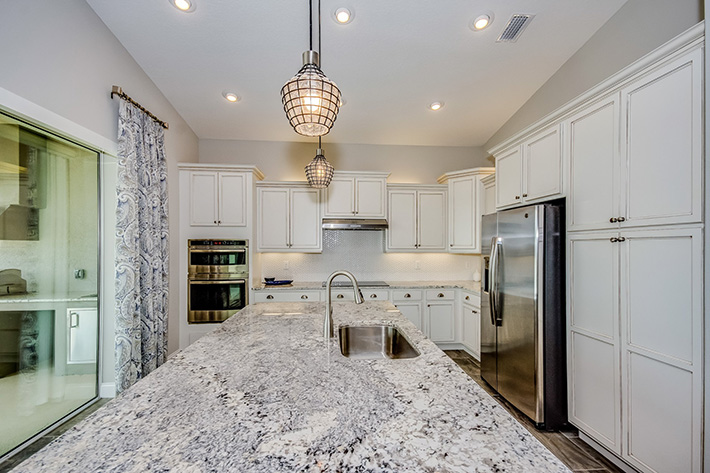Granite countertops have become a staple in modern kitchens and bathrooms, known for their durability, aesthetic appeal, and timeless elegance. Derived from natural stone, granite is formed through the cooling and solidification of magma, resulting in a hard and dense material. This geological process gives each slab of granite a unique pattern, texture, and color, making it a popular choice for homeowners looking to add a distinctive touch to their spaces.
Introduction to Granite Countertops
Granite countertops offer a blend of beauty and functionality, enhancing the visual appeal of any room while providing a robust surface for daily use. The natural variations in color and veining add a sense of luxury and uniqueness that synthetic materials often lack. Whether in a bustling kitchen or a serene bathroom, granite countertops can elevate the design and functionality of the space.
In this article, we will delve into the myriad benefits of granite countertops, explore various design styles, discuss the installation process, and provide insights into maintenance and care. We will also compare granite to other popular countertop materials, examine cost factors, and offer tips on how to choose the right granite countertop for your home. By the end of this comprehensive guide, you will have a clear understanding of why granite countertops are a favored choice among homeowners and designers alike.
Benefits of Granite Countertops
Granite countertops offer numerous advantages that make them a preferred choice for many homeowners. One of the most significant benefits is their durability. Granite is one of the hardest natural stones, which makes it resistant to scratches, heat, and everyday wear and tear. This durability ensures that granite countertops can withstand the rigors of a busy kitchen or bathroom, maintaining their beauty and functionality for years to come.
Another notable benefit is the aesthetic appeal of granite countertops. The natural stone comes in a wide variety of colors and patterns, ranging from subtle and understated to bold and dramatic. This diversity allows homeowners to choose a granite slab that perfectly complements their interior design style. Additionally, the unique patterns and veining found in granite mean that no two countertops are exactly alike, adding a personalized touch to any space.
Granite countertops also contribute to the overall value of a home. They are often seen as a high-end feature that can enhance the resale value of a property. Potential buyers are typically drawn to the elegance and durability of granite, making it a worthwhile investment for homeowners planning to sell their home in the future.
Furthermore, granite is a naturally sanitary material. Its non-porous surface makes it resistant to bacteria and other contaminants, making it a safe and hygienic choice for kitchen and bathroom countertops. Proper sealing further enhances its resistance to staining and moisture, ensuring that the surface remains clean and easy to maintain.
In summary, the benefits of granite countertops include their exceptional durability, unique aesthetic appeal, potential to increase home value, and their sanitary properties. These attributes make granite an ideal choice for those seeking a blend of beauty and practicality in their countertop material.
Popular Granite Countertop Design Styles
Granite countertops come in a myriad of design styles, allowing homeowners to find the perfect match for their aesthetic preferences and functional needs. From classic to contemporary, the versatility of granite makes it suitable for various interior design styles.
One popular design style is the classic or traditional look. Traditional granite countertops often feature neutral colors such as whites, creams, and grays, with subtle veining that adds depth and character without overwhelming the space. These countertops pair well with wooden cabinetry and timeless design elements, creating a warm and inviting atmosphere.
For those who prefer a more modern or contemporary aesthetic, granite countertops with bold patterns and dramatic colors are an excellent choice. Darker shades like black, deep blues, and greens with striking veins or speckles can create a stunning focal point in the kitchen or bathroom. Pairing these countertops with sleek, minimalist cabinetry and modern fixtures can enhance the overall contemporary vibe.
Another popular design style is the rustic or farmhouse look. Granite countertops in earthy tones such as browns, beiges, and warm grays can complement the natural elements often found in rustic designs. These countertops work well with reclaimed wood, vintage fixtures, and other rustic accents, creating a cozy and charming space.
Transitional design is another style where granite countertops shine. This style blends traditional and contemporary elements, creating a balanced and harmonious look. Granite countertops in neutral shades with moderate veining can seamlessly integrate with both classic and modern design features, offering flexibility in decor.
For those seeking a more eclectic or personalized style, the wide variety of granite colors and patterns allows for creative expression. Combining different granite slabs or integrating granite with other materials like wood or metal can result in a unique and customized look that reflects the homeowner’s personality.
In conclusion, granite countertops offer a range of design styles from classic to contemporary, rustic to eclectic, providing options to suit any taste and decor. The natural beauty and diversity of granite ensure that there is a perfect slab for every design vision.
Installation Process and Considerations
The installation of granite countertops is a meticulous process that requires careful planning and execution to ensure a perfect fit and long-lasting durability. Understanding the steps involved and the considerations to keep in mind can help homeowners prepare for a successful installation.
The first step in the installation process is measuring and templating. Accurate measurements of the countertop area are crucial to create a template that guides the cutting and fabrication of the granite slab. Professional installers use specialized tools to measure the space precisely, taking into account any sinks, appliances, or other fixtures that need to be accommodated.
Once the measurements are taken, the next step is selecting the granite slab. Homeowners can visit a granite showroom or supplier to choose the specific slab they want for their countertops. It’s important to view the entire slab to appreciate its full pattern and color variations, ensuring it matches the desired aesthetic.
After selecting the slab, the granite is cut and fabricated according to the template. This process involves cutting the slab to the exact dimensions, shaping the edges, and creating openings for sinks and other fixtures. Edge profiles can be customized, ranging from simple square edges to more intricate designs like ogee or bullnose.
The next step is the actual installation of the granite countertops. The installers will carefully transport the cut and fabricated slabs to the home, where they will be positioned and secured onto the cabinetry. Proper support and leveling are critical to prevent any stress or movement that could cause cracks or damage over time. The seams between granite pieces are filled and smoothed to create a seamless appearance.
Sealing the granite is another important step in the installation process. Granite is a porous material, and sealing helps protect it from stains and moisture. The initial sealing is done after installation, and periodic resealing is recommended to maintain the countertop’s protective layer.
Homeowners should also consider the cost and timeline of the installation. Granite countertops are a significant investment, and prices can vary based on the type of granite, edge profile, and any additional features like backsplashes. The installation process can take several weeks from initial measurement to final placement, so planning ahead is essential.
In summary, the installation of granite countertops involves precise measuring, careful slab selection, expert fabrication, and meticulous installation. Proper sealing and maintenance ensure the countertops remain beautiful and durable for years to come. Understanding these steps and considerations can help homeowners navigate the installation process smoothly and achieve the best results.
Maintenance and Care for Granite Countertops
Proper maintenance and care are essential to keep granite countertops looking their best and ensure their longevity. While granite is a durable material, it requires regular upkeep to maintain its beauty and functionality.
The first step in maintaining granite countertops is sealing. Granite is naturally porous, which means it can absorb liquids and become stained if not properly sealed. Sealing the countertops creates a protective barrier that prevents spills from penetrating the stone. It’s recommended to reseal granite countertops every 1 to 2 years, depending on usage and the type of sealant used.
Cleaning granite countertops is straightforward but requires some attention to detail. Daily cleaning should involve wiping down the surface with a soft cloth and a mild soap solution or a specially formulated granite cleaner. Avoid using harsh chemicals, abrasive cleaners, or acidic substances like vinegar, as they can damage the sealant and dull the stone’s finish.
Preventing damage is another key aspect of granite countertop care. Although granite is heat-resistant, it’s advisable to use trivets or hot pads under hot pots and pans to prevent thermal shock, which can cause cracks. Similarly, using cutting boards rather than cutting directly on the granite helps avoid scratches and preserves the sharpness of knives.
Addressing spills and stains promptly is crucial to maintaining the appearance of granite countertops. Blotting spills immediately and using a poultice for stubborn stains can prevent them from setting into the stone. For organic stains like wine or coffee, a mixture of baking soda and water can be applied to lift the stain. For oil-based stains, a mixture of baking soda and water can be effective.
Polishing granite countertops can enhance their shine and bring out the natural beauty of the stone. There are commercial granite polishes available that can be applied periodically to maintain the glossy finish. However, it’s important to follow the manufacturer’s instructions and avoid over-polishing, which can lead to a buildup of residue.
Regular inspection of the countertops for signs of wear, cracks, or damage is recommended. Addressing any issues promptly can prevent further damage and extend the lifespan of the countertops. If any repairs are needed, it’s best to consult a professional to ensure they are done correctly.
In conclusion, maintaining and caring for granite countertops involves regular sealing, gentle cleaning, preventing damage, addressing spills promptly, and periodic polishing. With proper care, granite countertops can retain their beauty and functionality for many years, making them a valuable addition to any home.







